My Celiac Guide to Eating Gluten-Free in Japan
ShareWondering how you can eat gluten free in Japan? Check out my guide below!
- My experience
- Is Japan Celiac Friendly?
- Japanese Allergen Ingredient Labelling Laws
- Words on Labels to Look Out For
- Useful Japanese phrases to use at restaurants and food stores in Japan
- Other Japanese words, warning statements and phrases that might be helpful to know
- Japanese Restaurant Card
- Tips on Being Gluten-Free When Travelling in Japan
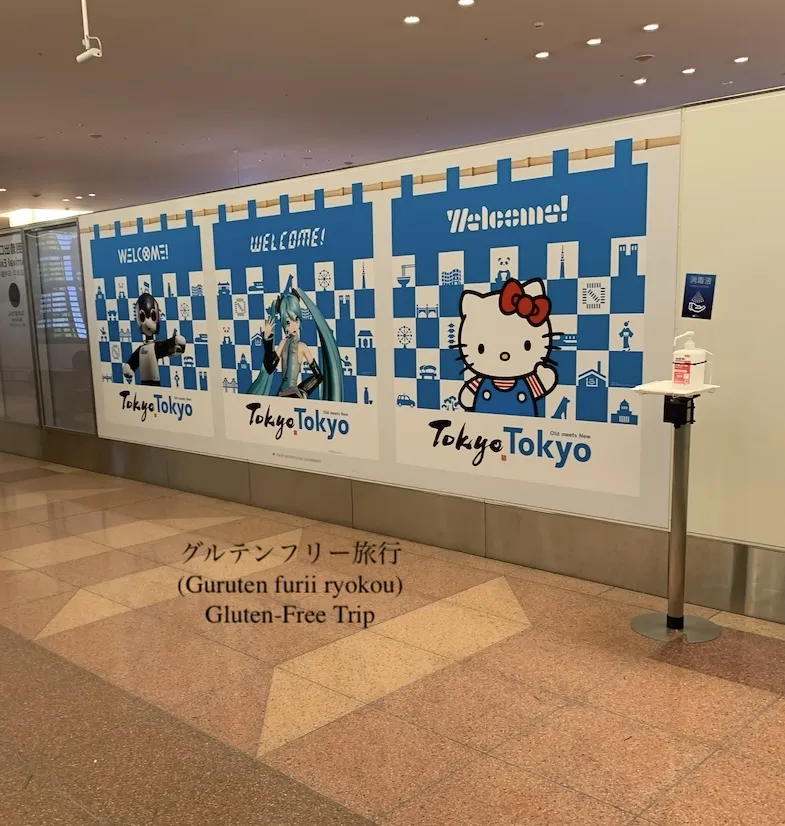
My experience
I thought I would share how I handled being gluten-free during my last trip to Japan. This was my first trip back since being diagnosed with celiac disease, and I was a little worried about how I would cope. What would I eat? Where would I eat? How would my food restrictions affect my family and friends?
So, how did it go? Actually I had a good trip. It was definitely different from my trips prior to being diagnosed with celiac disease. I did miss the spontaneity of eating whatever I wanted where ever I wanted. Was it easy? No, it was harder to find gluten-free food compared to Canada, but I think that is because celiac disease and gluten-intolerance are not common in Japan. I found that with planning and flexibility it was doable and enjoyable for me.
It was important to me to acknowledge that my food experience wouldn't be the same as prior to my celiac diagnosis, and accept that I wouldn't have the same choices as a non-celiac, but that I could still enjoy myself. I decided to enjoy the challenge of finding things I could eat and make my trip more than just about the food. If I hadn't decided to think this way I believe I would have been frustrated.
Now these are just my experiences and my opinions only. Everyone's experience in Japan will be unique, due to their comfort levels with cross-contamination, other food intolerances or allergies, where you go in Japan (rural versus urban) and your budget.
I found that by researching safe restaurants and gluten-free bakeries in the cities I would be visiting ahead of time was useful. They were limited, but there are some in major cities. My husband is Japanese, but we were not always together and my Japanese is limited, therefore I studied some Japanese words to look out for on food labels and some phrases I could use at restaurants, and food stores.
It is easy to supplement your diet by buying fruit and vegetables at Supermarkets and Convenience Stores. Below is an example of some delicious strawberries I found at one of the convenience stores.
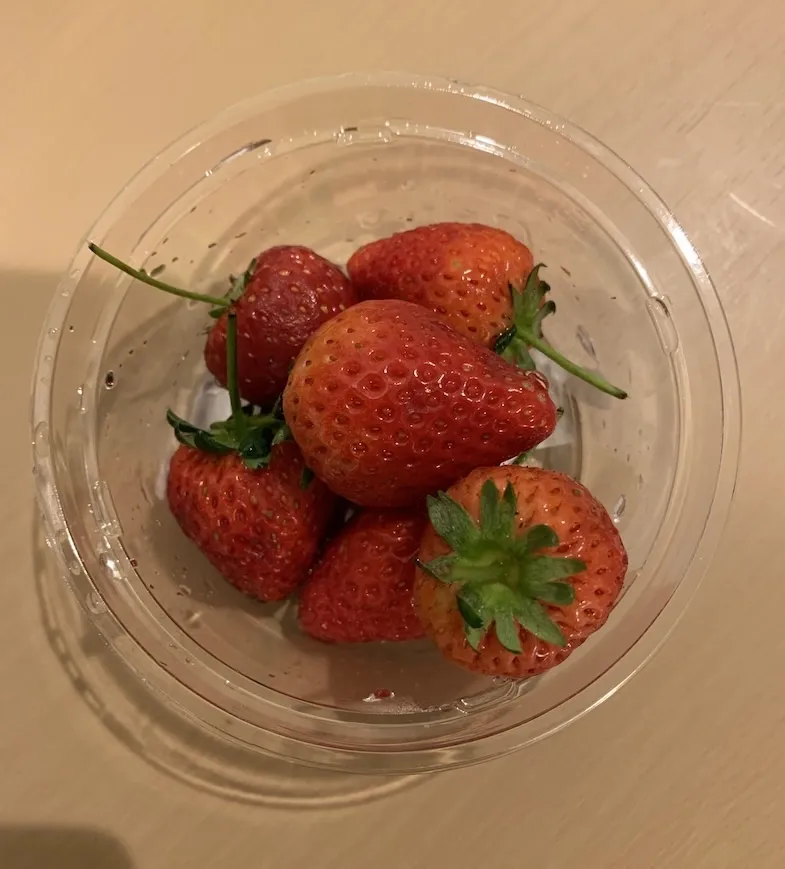
Is Japan Celiac Friendly?
Is Japan celiac friendly? Compared to western countries the answer is Not really. It is challenging if you just want to eat out at restaurants and cafes. The average Japanese person doesn't know what celiac disease or gluten intolerance is. Japanese cusine is rife with gluten containing ingredients such as wheat in soya sauce, and barley in sweets, some teas, some miso pastes, and some vinegars. Soya sauce is used as a seasoning in many dishes. Also, culturally it is not common for chef's to modify their dishes.
As I said before it was challenging to be a celiac in Japan but, it was possible to eat gluten-free. Especially in big cities such as Tokyo, Osaka and Kyoto there were a few gluten-free restaurants, cafes, and bakeries. I found some specialty shops and supermarkets that sell gluten-free food, products and soya sauce. I even found gluten-free bread at a large Aeon Supermarket in rural Fukuoka prefecture. I do recommend having an accommodation with a kitchen or at least a microwave, then you can shop for naturally gluten-free food at grocery stores and make yourself meals.
I found staff at supermarkets and restaurants were kind, took allergies seriously and wanted to be helpful, but didn't always understand the concept of gluten-free. Often gluten-free and vegan were thought of together. Also, gluten-free was sometimes thought of as wheat free only. I know that celiac disease is an autoimmune disease and not an allergy, but in Japan celiac disease is not well known or understood. Staff were aware of allergies to wheat. Therefore, I personally found it easier to state that I was allergic to wheat and barley and ask if they had any recommendations from their menu. This worked for me because my Japanese language skills are very minimal, and I don't feel like educating every person I met at grocery stores or restaurants as to what celiac disease is.
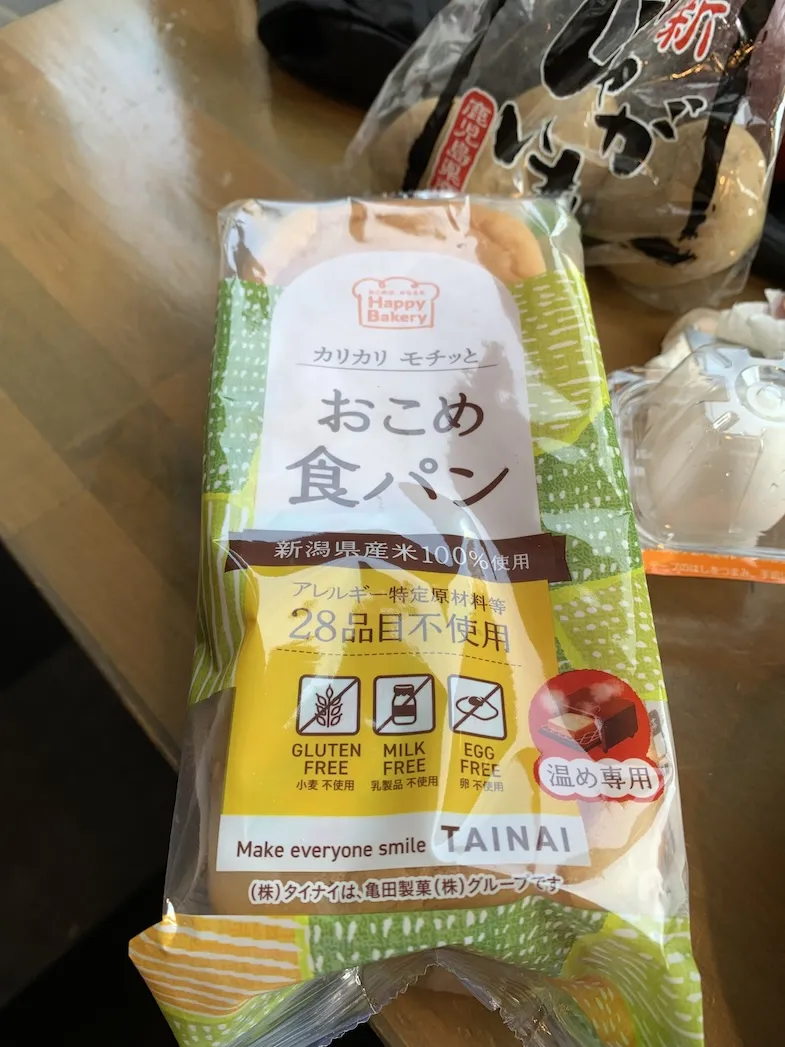
Above is an example of Happy Bakery Gluten-free bread. The staff at the store helped me find the gluten-free area. You can see that they have used the English words "gluten-free" on the packaging. This bread is good, but does need to be either heated up in a microwave or toasted.
Japanese Allergen Ingredient Labelling Laws
In Japan the only gluten ingredient that must be on food labels by law is "wheat". Wheat is recognized as an allergen in Japan. Unfortunately at the time of writing this blog, Japan doesn't recognize barley, rye, oats and gluten as an allergen and therefore they don't need to be included on ingredients labels, only "wheat" does. This makes it difficult for people with celiac disease and gluten intolerance because barley can be found in many foods in Japan.
So, anything that may have barley in it must be assumed to be gluten. This means starch, yeast, mizuame are all suspect. You need to be careful of mayonnaise, vinegars, one tea called mugi-cha (oomugi means barley) and sweets especially traditional Japanese sweets.
Below is a list of the seven allergens that are required to be labelled when present in food products, and the twenty one that are recommended by Japan's Food Labelling Act. As you can see barley is not on the list. Neither is rye, oats or gluten.
Food Labeling Laws in Japan
Required Ingredients
- Buckwheat
- Crab
- Egg
- Milk/Dairy Product
- Peanut
- Shrimp
- Wheat
21 Recommended
- Abalone
- Almond
- Apple
- Banana
- Beef
- Cashew
- Chicken
- Gelatin
- Kiwi fruit
- Mackerel
- Matsutake mushroom
- Orange
- Peach
- Pork
- Salmon
- Salmon roe
- Sesame
- Soybeans
- Squid
- Walnut
- Yam
Food products that contain any of the designated allergens, such as wheat must clearly indicate them on the label. This is typically done by listing the allergen(s) on the packaging in bold or capital letters to make them stand out. Sometimes the words are in a different colour.
Some packages may use symbols to represent common allergens. For example, a small image of wheat or a peanut might be used to indicate that the product contains those allergens.
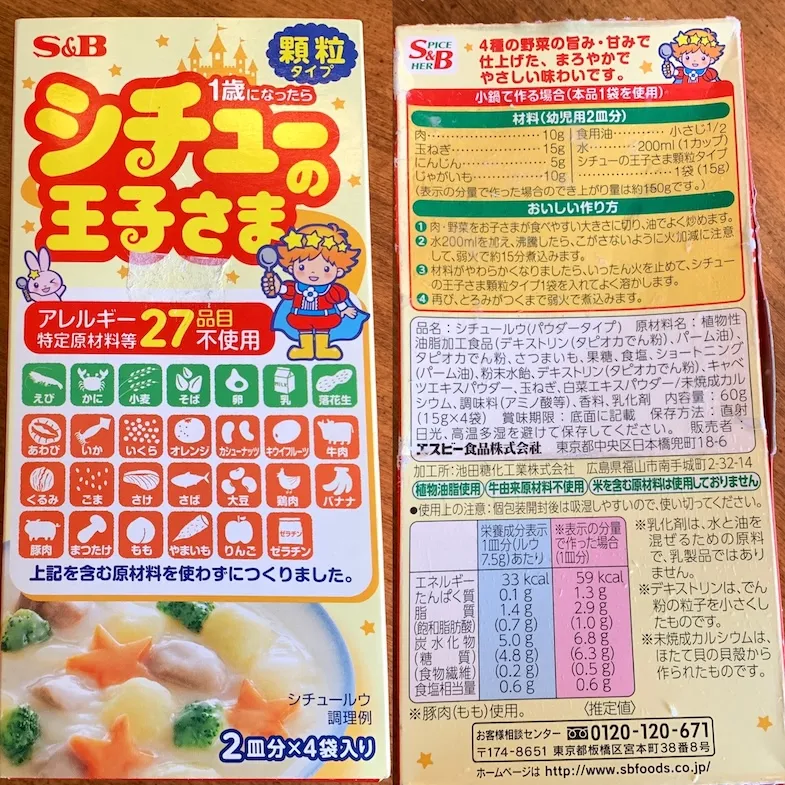
Here is an interesting and I think useful link to Japan's Food Labelling System for Overseas Travellers published by the Japanese Government Consumer Affairs Agency. They have an "Allergen Communication Sheet" that you can copy and use to communicate your needs.
There are no specific laws in Japan regarding cross-contamination labeling, but manufactures are encouraged to provide such information voluntarily, by using "may contain" or "processed in a facility that also handles (allergen)" statements.
Restaurants and food service establishments are also required to inform customers about the presence of allergens in their dishes. For us celiac's that would be wheat only.
Please be aware that food products with the English words "Gluten-Free" on them, without an international gluten free certification label need to be treated with caution. Do read the ingredients label! The term "gluten-free" is not regulated in Japan and may be used to mean "wheat free" but not barley or rye free. Food products whether international or Japanese that have a certified gluten free mark should be safe, but again check the ingredients label.
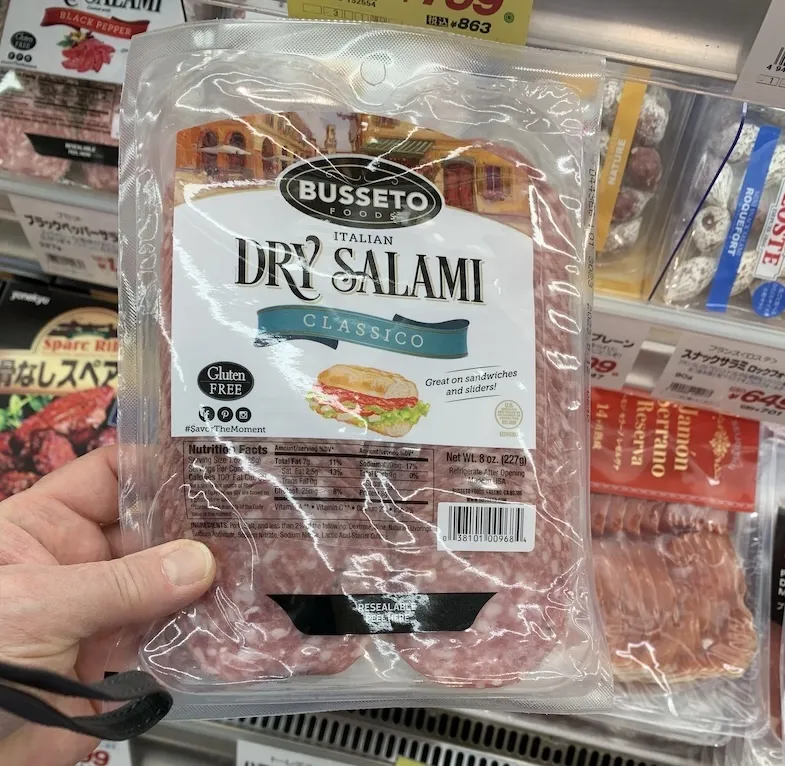
By familiarizing yourself with these Japanese allergen labeling laws, you can make more informed choices and better manage your dietary needs while in Japan.
Japanese words to look for on food labels if you are gluten-free.
Here are the four Japanese words that I found useful to know when reading food labels in Japan.
- wheat 小麦 komugi
- barley 大麦 oomugi
- malt 麦芽 bakuga
- mizuame みずあめ (水飴).
You may have noticed that wheat and barley share a kanji.
麦 mugi
The above kanji meaning is "mugi" which is an overall cover term that encompasses the grains: wheat, barley, rye and oats. I find memorizing this kanji is helpful for reading ingredients labels. It is usually pronounced "moo-gee", but sometimes "baku" as in bakuga meaning malt.
Words on Labels to Look Out For
- 小麦wheat (komugi)
- 小麦粉 wheat flour (komugiko)
- 小麦澱粉 wheat starch (komugi denpun)
- 小麦胚芽 wheat germ (komugihaiga)
- スペルト spelt (superuto) A type of wheat called triticum
- 大麦 barley (oomugi)
- 麦芽 malt (bakuga)
- 麦茶 barley tea (mugi cha)
- ライ麦 rye (raimugi) or ライ (rai)
- オーツ麦 oats (ootsu mugi)
- 加工された澱粉 processed starch (kakō sa reta denpun)
- みずあめ (水飴) sweet syrup (millet jelly) (mizuame) (literally says water + sweet) May contain barley, if it does it may be labelled mugi mizuame (麦水飴). But, it could just be labelled mizuame (水飴) and not state the starch used.
- 香料 flavoring (kouryou) *if it contains wheat, that would be listed as it is an allergen in Japan*
- 穀物酢 grain vinegar (kokumotsu-su)is a vinegar which can contain wheat.
- アレルギー allergy (arerugii)
- グルテン gluten (guruten)
- グルテンフリー gluten-free (guruten furii)
- 味噌 miso
- 醤油 or しょうゆ, soya sauce (shōyu)
Mizuame is an ingredient to be careful of in Japan. Labelling laws do not require manufactuers to indicate the type of starch they use. It could be rice, sweet potato, potato, barley. Therefore, caution is advised when you see this in an ingredients list because if barley is used it wouldn't be safe for a celiac. Mizuame is similar to corn or glucose syrup.
I've heard that some celiac's in Japan do eat foods with mizuame. It is your personal decision to make. If you are spending a long time in Japan, you could try to contact the manufacture to see if they could tell you the type of mizuame starch they use.
Another phrase to look out for would be the caution statement: "Manufactured in the same facility as products that contain wheat" which can be written in Japanese as: 小麦を含む製品と同じ設備で製造されています。 (Kōmugi o fukumu seihin to onaji setsubi de seizō sareteimasu).
If I have missed a word you found important, please let me know. How did you find reading ingredients labels in Japan?
Useful Japanese phrases to use at restaurants and food stores in Japan
I hope that these phrases will help you communicate your dietary needs effectively in Japan.
- 小麦と大麦にアレルギーがあります I'm allergic to wheat and barley. (Komugi to oomugi ni arerugii ga arimasu.)
- 小麦、大麦、ライ麦を避けなければなりません I must avoid wheat, barley, and rye. (Komugi, ōmugi, raimugi o sakenakereba narimasen.)
- 小麦、大麦、またはライ麦は入っていますか Does it have wheat, barley, or rye? (Komugi, ōmugi, matawa raimugi wa haitte imasu ka?)
- この飲み物には小麦や大麦が含まれていますか Does this drink contain wheat or barley? (Kono nomimono ni wa komugi ya ōmugi ga fukumarete imasu ka?)
- この料理に小麦粉は使われていますか Is this dish made with wheat flour? (Kono ryōri ni komugiko wa tsukawarete imasu ka?)
- アレルギーメニューはありますか Do you have an allergy menu? (Arerugi menyou wa arimasu ka?)
- おすすめは何ですか What do you recommend? (Osusume wa nan desu ka?)
- __なしで作れますか Can you make this without _________? (____nashi de tsukure masuka?)
- 醤油抜きでください No soya sauce please. Suminasen. (Shoyu nuki de kudasai.)
- これはグルテンフリーですか Is it gluten-free? (Kore wa guruten furii desu ka?)
- グルテンフリーの食品はありますか Do you have gluten-free options? (Guruten furī no shokuhin wa arimasu ka?)
- グルテンフリーのメニューはありますか Do you have a gluten-free menu? (Guruten furii no menyuu wa arimasu ka?)
Possible answers you might hear to the above questions.
- はい、小麦が含まれています Yes, it contains wheat. (Hai, komugi ga fukumareteimasu)
- いいえ、小麦は含まれていません No, it doesn't contain wheat. (Iie, komugi wa fukumareteimasen)
- 食べても安全です / 飲んでも安全です It is safe to eat/drink. (Tabetemo/Nandemo anzen desu.)
- グルテンフリー No gluten. (Guruten furii)
- これをおすすめしますWe recommend this. (Kore o osusume shimasu.)
- いいえ、安全なものはありません Nothing is safe. (Iie, anzen na mono wa arimasen.)
Staff may just wave their hand left and right in front of them and say "Iie summimasen" or "Chigaimasu" or "Dame". They aren't being rude, they just take allergies seriously and just don't think they can make food safely for you.
Other Japanese words, warning statements and phrases that might be helpful to know
- セリアック病 celiac disease (seriakku-byō)
- 小麦を含む施設で処理されいます Processed in a facility that also processes wheat. (komugi o fukumu shisetsu de shori saremasu)
- ____と同じ設備で製造されています Manufactured in a facility that also processes _______. (________ to onaji setsubi de seizou sareteimasu)
- 交差汚染 Cross-contamination warning. (kōsa osen)
- アレルギー物質を含む場合があります Contains allergens/May contain allergens. (Arerugī busshitsu o fukumu baai ga arimasu)
- 私はセリアック病です I don't think this sentence is useful in Japan, but just in case here is how to say, "I have celiac disease. (Watashi wa seriakku-byō desu.)
You will sometimes see "Gluten-Free" in English on some foods in stores.
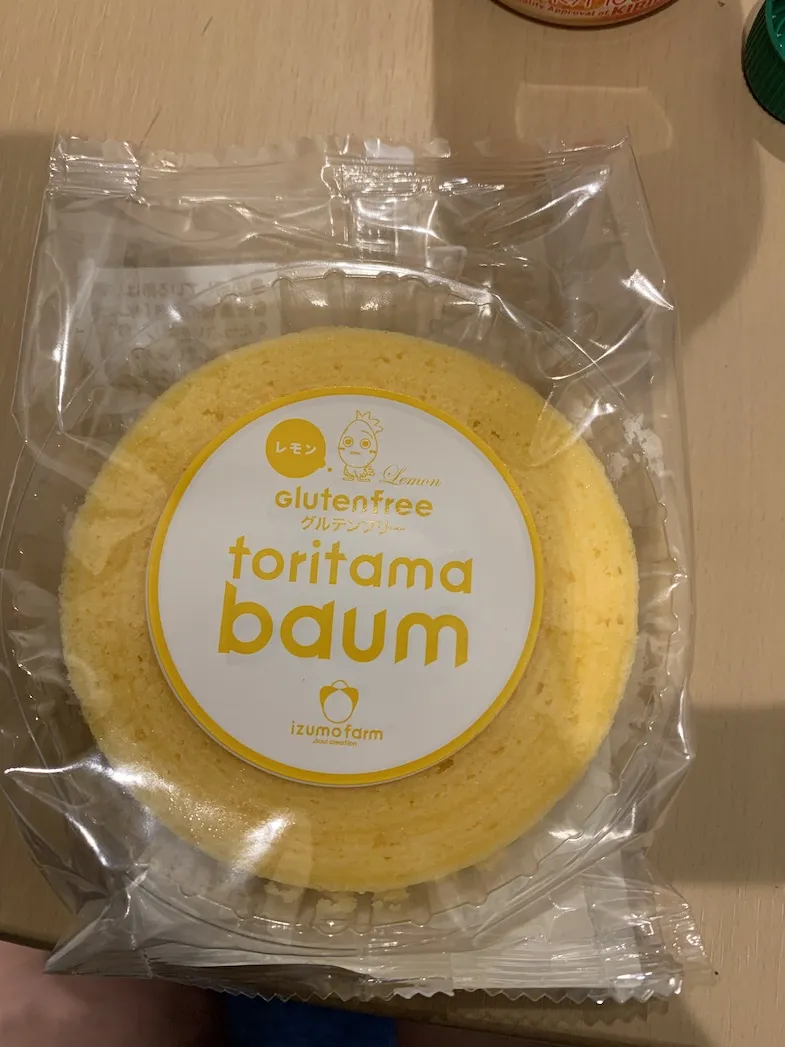
Japanese Restaurant Card
Here is a basic "Japanese Restaurant Card" you might find helpful.
Allergy Alert
I have an allergy to gluten. Gluten includes wheat, barley, rye, and their derivatives. Please make sure none of the dishes contain gluten.
Thank you.
アレルギーがあります。 私はグルテンにアレルギーがあります。 グルテンは小麦、大麦、ライ麦、およびそれらの派生物を含みます。 どの料理もグルテンを含まないようお願いします。
ありがとうございます。
Tips on Being Gluten-Free When Travelling in Japan
I highly recommend bringing toaster bags with you on your travels. They are great to use in toasters, toaster ovens and microwaves. I have even used them in a frying pan to fry a sandwich. They are great for avoiding cross-contamination on shared pans and appliances. I buy mine from Amazon.

If I'm flying I always try not to check in my luggage. I like to travel as light as possible. So, when I arrive at my destination I will buy a cheap cutting board, knife, and strainer for pasta. I will use them during my trip and then either leave them at my last accommodation or throw away. Good stores to buy such items in Japan are Daiso, Don Quijote or 100 Yen shops.
I used the Google Translate App, camera function, a lot in Japan when reading labels. It is easy to download and then you just use the camera function to take a photo of the ingredients label to translate from Japanese to English. I highly recommend using this app.
Below is an example of using the Google Translate App's camera function to translate a Japanese ingredients list that contains wheat.
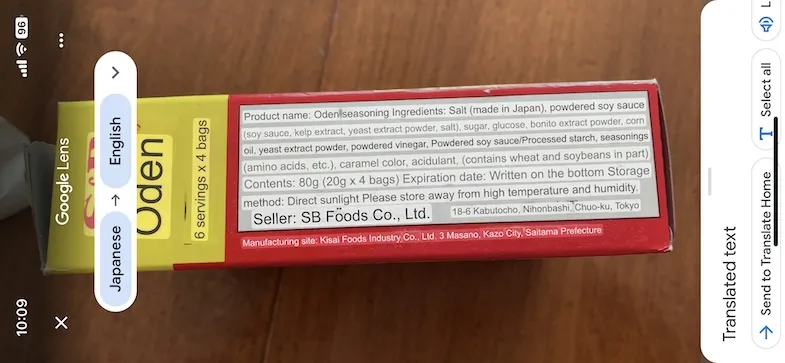
Below you can see the original Japanese label with "wheat" circled.
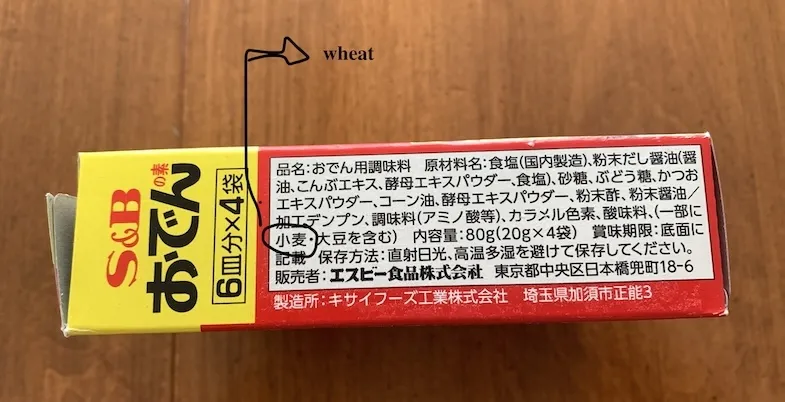
Even though I love the Google Translate App, I also like the convenience of carrying a sheet of paper with the relevant Japanese words I need to look out for on ingredients lists.
Check out my Gluten-free Food Options in Japan blog about Japanese Conbini Stores and supermarkets if you'd like more information on places to buy gluten-free food in Japan.
Remember to carefully check the labels for these terms to ensure that the product is safe for consumption if you have celiac disease, a gluten allergy or you're gluten intolerant. If unsure about a particular product, it's always best to error on the side of caution and not consume it. If you have time you could also contact the manufacturer for clarification.
Would love to here what your experience was like! Let me know below in the comments section!
Note: These are my personal experiences and opinions. Always seek out a medical opinion for medical concerns. Not sponsored. If sponsored I will always say so at the top of the post.